8.31.1. Open Response Assessments¶
Note
EdX offers full support for this problem type.
The topics in this section provide an overview and details about open response assessments.
For additional information, see Create an Open Response Assessment Assignment, Managing Open Response Assessment Assignments, and Accessing Metrics for ORA Assignments.
8.31.1.1. Introduction to Open Response Assessments¶
Open response assessments allow the course team to assign questions that might not have definite answers, such as text responses or short essays. Learners submit responses to questions, then each learner and the learner’s peers compare the responses to a rubric that you create. You can also allow learners to upload an image, a .pdf file, or another file of a type that you specify, to accompany their text responses.
Open response assessments can include self assessments, peer assessments, and staff assessments. In self assessments, learners compare their own responses to a rubric that you create. In peer assessments, learners compare their peers’ responses to the rubric. In staff assessments, a member of the course team evaluates the learner’s responses using the rubric.
In open response assessments, learners usually only see their own responses and any peer responses they assess. You can also allow learners to see the top scoring responses that their peers have submitted. For more information, see Top Responses.
Note
Open response assessments that are visible to all learners do not respect cohorts. In other words, it is possible for learners in one cohort to be asked to grade responses for learners in another cohort. If you want to make an open response assessment divided by cohort, you must create that assessment in a course component that is defined as cohort-specific. For more information about cohorts and creating cohort-specific course content, see Using Cohorts in Your Courses and Creating Cohort-Specific Course Content.
For more information about creating open response assessments, including step by step instructions, see the following sections.
- Best Practices for Open Response Assessments
- Elements of an Open Response Assessment
- How Scores for Open Response Assessments Are Calculated
- Create an Open Response Assessment Assignment
- Accessing Metrics for ORA Assignments
For information about viewing metrics and learner responses for released open response assessments, see Accessing Metrics for ORA Assignments.
For information about the learner experience with open response assessments, see Open Response Assessments in the edX Guide for Learners.
8.31.1.2. Best Practices for Open Response Assessments¶
Open response assessments can be a powerful teaching tool, but they are more effective in some situations than in others. In general, open response assessments are best suited to open-ended or project-based assignments with subjective essay answers and discussion. For example, open response assessments work well in humanities assignments where learners are encouraged to make subjective assessments of text, images, or other contributions, but they might not be the ideal tool in chemistry assignments where there are definitively correct or incorrect answers to questions.
Note
Do not add more than one ORA component in a course unit. Multiple ORA assignments in a unit cause errors when learners submit their assessments.
EdX suggests that you follow these guidelines and best practices when you use open response assessments in your courses.
Make sure you have a well designed and clear rubric. A good rubric is very important in helping to eliminate ambiguity in the peer grading process.
Make ORA assignments count toward only a small percentage of the final course grade, or make them ungraded.
In graded ORA assignments, consider setting the lowest possible score to a number higher than zero, so that learners can earn some credit for the work they have done, even if their peer assessors give them low grades.
Provide an ungraded practice ORA assignment prior to the first graded ORA assignment in the course, so that learners can understand the peer grading process and get the most out of the eventual graded ORA assignment.
Consider using ungraded ORA assignments to generate learner interaction and feedback without affecting grades.
Be wary of including too many ORA assessments in your course. Peer assessments are hard work for learners, and having to perform too many peer assessments can have a negative impact on learners’ course completion rates.
For a manageable experience, use staff assessment steps only in assignments that are available to a limited number of learners. For example, in courses that have cohorts enabled, you make the assignment containing the staff assessment step available only to members of one or more cohorts.
Set the Must Grade number higher than the Graded By number to minimize the chance that some responses will not be peer assessed. EdX recommends a setting such as Must Grade = 4 and Graded By = 3.
In ORA assignments, to allow enough time for peer assessments to be performed after learners have submitted their own responses, set the response due date and time at least one week before the peer assessment due date and time. If the response due time and peer assessment due time are close together, and a learner submits a response just before responses are due, other learners may not have time to perform peer assessments before peer assessments are due.
In discussion posts, provide guidance for peer grading of ORA assignments.
Consider extending due dates to allow the discussion moderation team to monitor course discussions for questions about, or reactions to, peer grading, and to address issues when necessary.
If learners raise concerns about ORA assignments in course discussions, course team members can perform actions such as deleting a learner’s history, or “state” for a problem so that he can submit his assignment again, overriding a learner’s grade, or removing a learner response from peer grading. If there are more widespread issues with peer grading, the course team can reduce the weight of the peer assessment within the final course grade or allow learners to drop the lowest graded assignment from their grades.
8.31.1.3. Elements of an Open Response Assessment¶
When you create an open response assessment assignment, you include several elements.
- One or more prompts, or questions.
- The rubric. One rubric is used to grade all the prompts in the assessment.
- One or more assessment steps. Assignments can include a learner training step, a peer assessment step, a self assessment step, and a staff assessment step.
Note
If you include a learner training step, you must also include a peer assessment step. The learner training step must come first, before the peer and self assessment steps. If you include a staff assessment step, it should be the final step in the assignment.
For step-by-step instructions for creating an open response assessment, see Create an Open Response Assessment Assignment.
8.31.1.3.1. Prompts¶
Each prompt, or question, that you want your learners to answer, appears near the top of the page, followed by a field where the learner enters a response. You can require your learners to enter text as a response, or you can allow your learners to both enter text and upload another file, such as an image or document.
Note
Uploaded files must be smaller than 5 MB in size. If learners upload an image, the file must be in .jpg, .gif, or .png format.
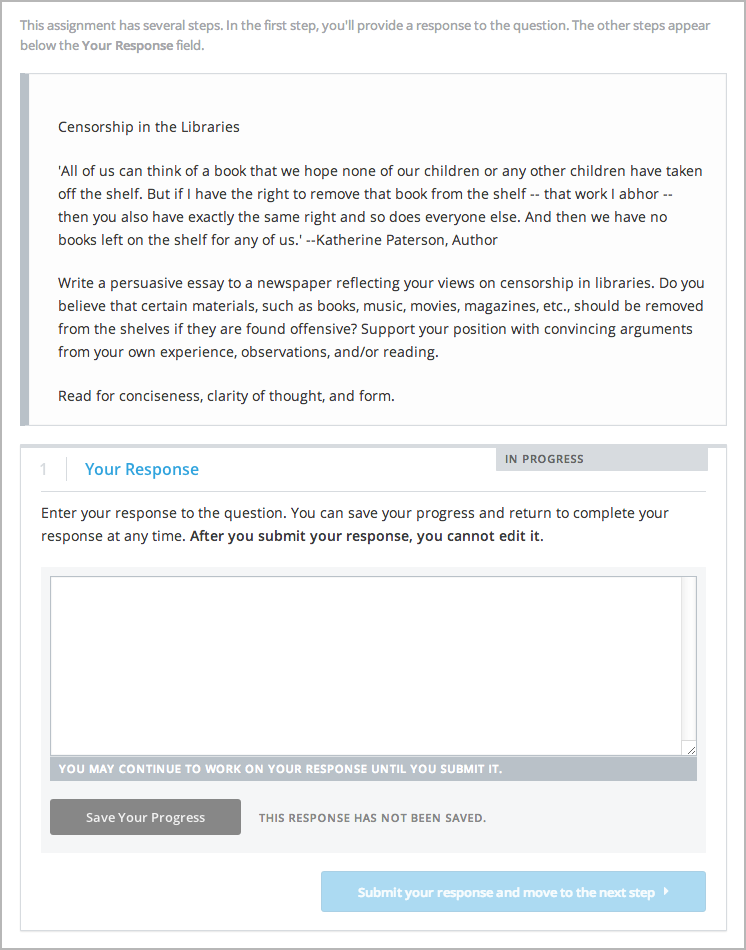
When you write each question, you can include helpful information for your learners, such as what they can expect after they submit responses, or the approximate number of words or sentences that their response should have.
Note
Each learner is limited to a total word count of 10,000 for all responses in an ORA assignment.
For more information, see Step 2. Add Prompts.
8.31.1.3.1.1. Asking Learners to Upload Other Files in Responses¶
For an open response assessment, you can ask your learners to upload an image, a .pdf file, or a file of another type as a part of their responses. Other learners evaluate the responses and their accompanying files during the peer assessment. Offering the option to upload a file in addition to a text response can give learners the opportunity to use tools and develop skills that are relevant to your course.
Before you decide to ask learners to upload other files along with their text responses, however, you should be aware of the following limitations and best practices.
- During the peer assessment step, learners download the files that other learners uploaded. To reduce the potential for problems from files with malicious content, learners cannot upload files with certain file extensions. For a complete list, see Prohibited File Extensions.
- Course teams can only access uploaded files for one learner at a time. Uploaded file content is not included in the reports of answer submissions available from the Instructor Dashboard, and course data packages do not include any of the uploaded files.
- You cannot require your learners to upload files. You can only give them the option to do so.
- All responses must include some response text. Learners cannot submit a response that contains only an uploaded file.
- Learners can submit only one file with each response.
- Files must be smaller than 5MB in size.
- Image files must be in .jpg, .gif, or .png format.
For more information, see Allow Learners to Submit Files (optional).
8.31.1.3.1.2. Prohibited File Extensions¶
This topic lists the file extensions for the set of file types that learners are prohibited from uploading as part of an open response assessment on edx.org or edX Edge. When you define a set of custom file types for learners to upload with their responses, you cannot specify these file types. The extensions on this list are selected and maintained by the development operations team at edX, and are subject to change.
This set of file extensions is provided as the default for Open edX installations. Open edX system administrators can update this list. For more information, see Prohibiting Submission of Specified File Types.
| A through I | .action, .apk, .app, .application, .bat, .bin, .cmd, .com, .command, .cpl, .csh, .dmg, .exe, .gadget, .hta, .inf, .ins, .inx, .ipa, .isu |
| J through P | .jar, .job, .jse, .lnk., msc, .msh, .msh1, .msh2, .mshxml, .msh1xml, .msh2xml, .msi, .msp, .mst, .osx, .out, .paf, .pif, .prg, psc1, .psc2, .ps1, .ps1xml, .ps2, .ps2xml |
| Q through Z | .reg, .rgs, .run, .scf, .scr, .sct, .shb, .shs, .u3p, .vb, .vbe, .vbs, .vbscript, .workflow .ws, .wsc, .wsf, .wsh |
8.31.1.3.2. Rubric¶
Your assignment must include a rubric that you design. The same rubric is used for all the types of assessments (self, peer, or staff). The person performing the assessment sees the rubric when she begins grading, and compares the submitted response to the rubric.
Rubrics consist of criteria and options.
Each criterion has a name, a prompt, and one or more options.
The name is a very short summary of the criterion, such as “Ideas” or “Content”. Criterion names generally have just one word. Because the system uses criterion names for identification, the name for each criterion must be unique. Criterion names do not appear in the rubric that learners see when they are completing peer assessments, but they do appear on the page that shows the learner’s final grade.
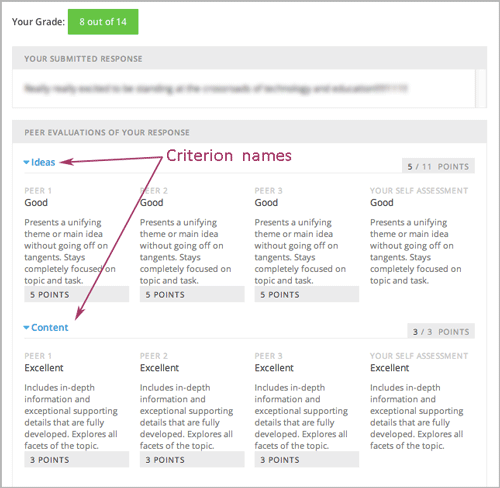
The prompt is a description of the criterion.
Options describe how well the response satisfies the criterion.
Each option has a name, an explanation, and a point value.
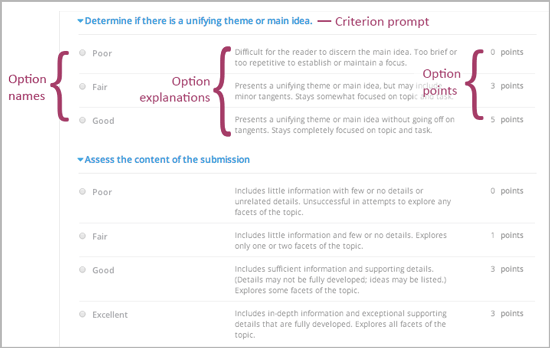
Different criteria in the same assignment can have different numbers of options. For example, in the image above, the first criterion has three options and the second criterion has four options.
Note
You can also include criteria that do not have options, but that do include a field where learners or staff can enter feedback. For more information, see Provide Only Comment Fields for Individual Criteria.
You can see both criterion and option names when you access assignment information for an individual learner. For more information, see Accessing Metrics for ORA Assignments.
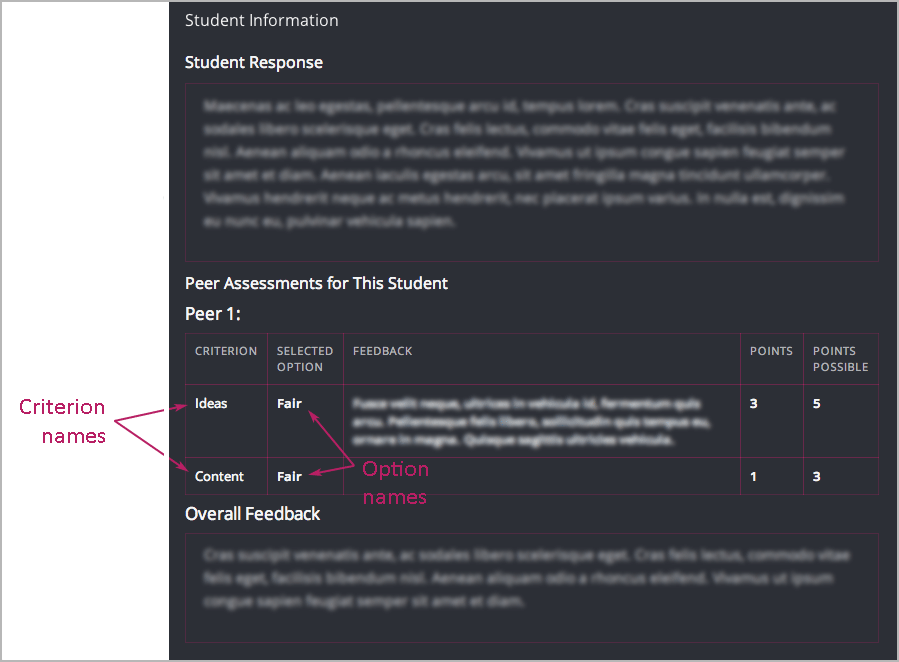
When you create your rubric, decide how many points each option will receive, and make sure that the explanation for each option is as specific as possible. For example, one criterion and set of options may resemble the following.
Criterion
Name: Origins
Prompt: Does this response explain the origins of the Hundred Years’ War? (5 points possible)
Options
| Points | Name | Explanation |
|---|---|---|
| 0 | Not at all | This response does not address the origins of the Hundred Years’ War. |
| 1 | Dynastic disagreement | This response alludes to a dynastic disagreement between England and France, but doesn’t reference Edward III of England and Philip VI of France. |
| 3 | Edward and Philip | This response mentions the dynastic disagreement between Edward III and Philip VI, but doesn’t address the role of Salic law. |
| 5 | Salic law | This response explains the way that Salic law contributed to the dynastic disagreement between Edward III and Philip VI, leading to the Hundred Years’ War. |
Note
For peer grading, the most effective rubrics are as concrete and specific as possible. Many novice learners will be unqualified to make the types of value judgments required for more holistic rubrics. In addition, edX suggests using clear, simple language in rubrics.
For more information, see Step 3. Add the Rubric.
8.31.1.3.3. Assessment Steps¶
In your assignment, you also specify the assessment steps. You can set the assignment to include some combination of the following steps.
Note
If you include a learner training step, you must also include a peer assessment step. The learner training step must come before peer or self assessment steps. If you include both peer and self assessment steps, edX recommends that you place the peer assessment before the self assessment. If you include a staff assessment step, it should be the final step in the assignment.
You can see the type and order of the assessments when you look at the assignment. In the following example, after learners submit a response, they complete a learner training step (“Learn to Assess Responses”), complete peer assessments on other learners’ responses (“Assess Peers”), and then complete self assessments (“Assess Your Response”).
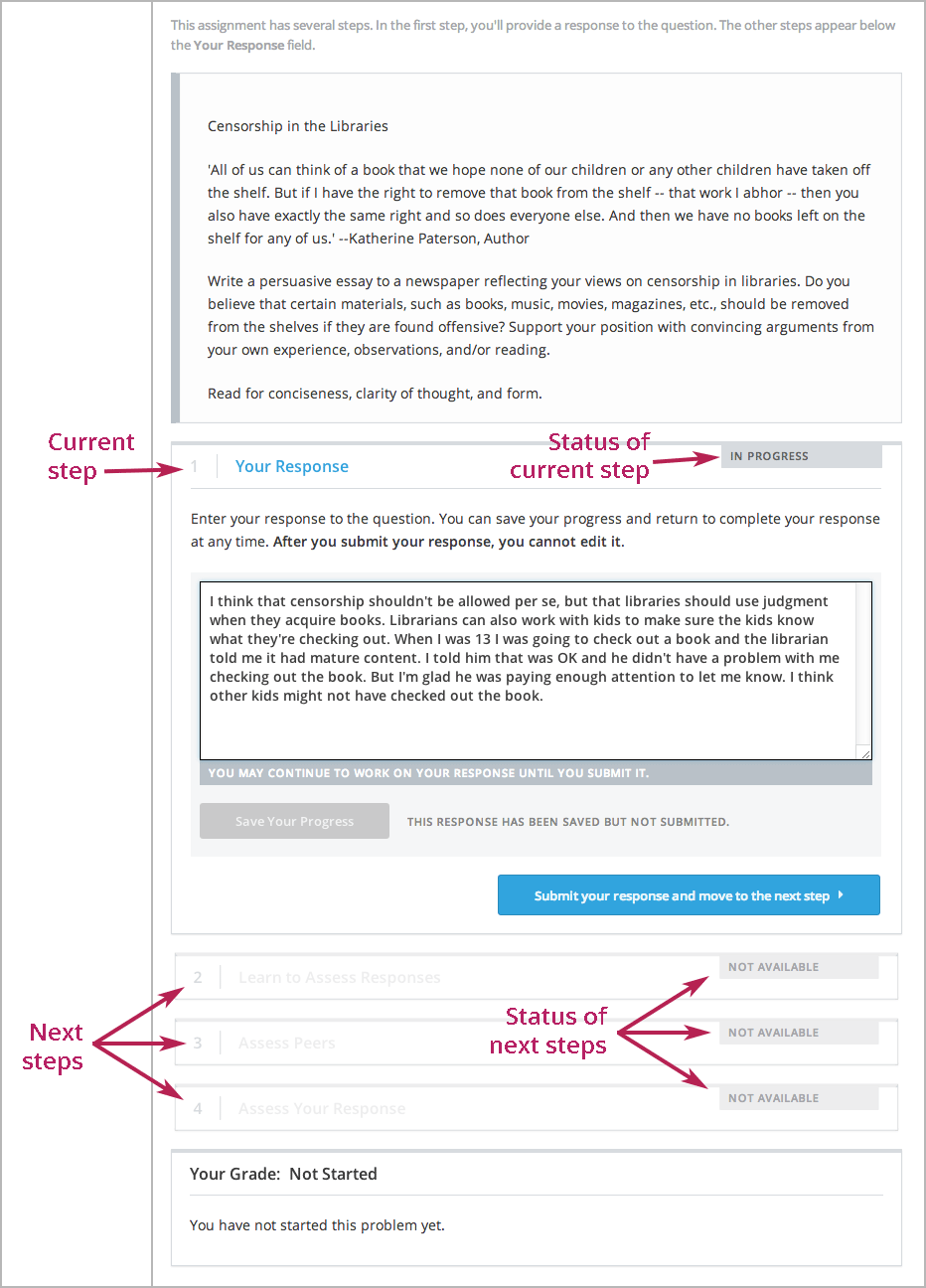
8.31.1.3.3.1. Learner Training Step¶
Learner training steps teach learners to perform their own assessments. A learner training assessment contains one or more sample responses that you write, together with the scores that you would give the sample responses. Learners review these responses and try to score them the way that you scored them.
Note
If you include a learner training step, you must also include a peer assessment step. The learner training step must come before any peer and self assessment steps.
In a learner training assessment, the Learn to Assess Responses step opens immediately after a learner submits a response. The learner sees one of the sample responses that you created, along with the rubric. The scores that you gave the response do not appear. The learner also sees the number of sample responses that he or she will assess.
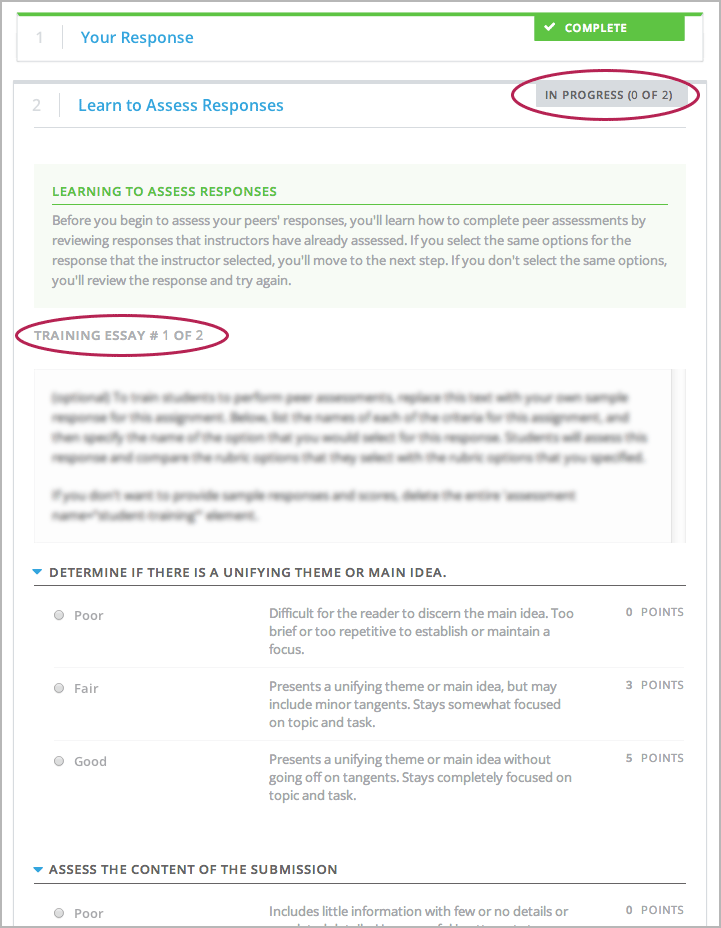
The learner selects an option for each of the assignment’s criteria, and then selects Compare your selections with the instructor’s selections. If all of the learner’s selections match the selections defined by the course team, the next sample response opens automatically.
If any of the learner’s selections differ from those specified by the course team, the learner sees the response again, and the following message appears above the response.
Learning to Assess Responses
Your assessment differs from the instructor's assessment of this response. Review the
response and consider why the instructor may have assessed it differently. Then, try
the assessment again.
For each of the criteria, the learner sees one of the following two messages, depending on whether the learner’s selections matched those of the course team.
Selected Options Differ
The option you selected is not the option that the instructor selected.
Selected Options Agree
The option you selected is the option that the instructor selected.
For example, the following learner chose one correct option and one incorrect option.
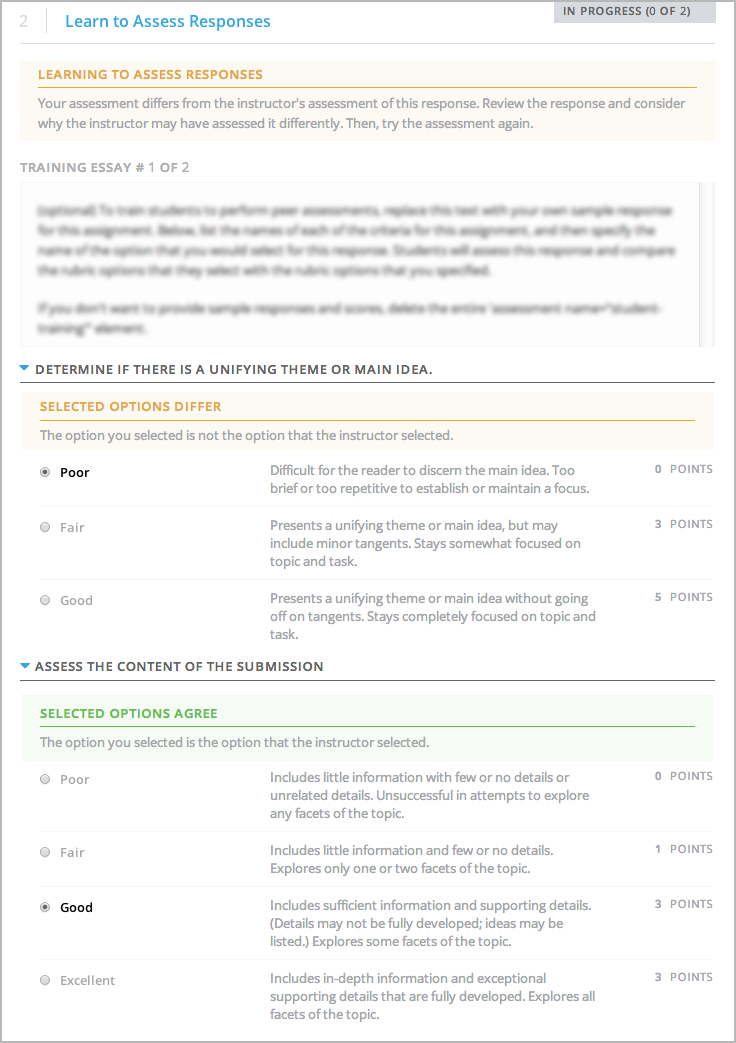
The learner continues to try scoring the sample response until the learner’s scoring for all criteria matches the scoring defined by the course team.
For more information, see Learner Training.
8.31.1.3.3.2. Peer Assessment Step¶
In the peer assessment step, learners review the responses of other learners in the course. For each response, they select an option for each criterion in your rubric based on the response. Learners can also provide text feedback, or comments, on each response.
If you include both peer and self assessment steps, edX recommends that you place the peer assessment before the self assessment.
For information about how peer assessments affect a learner’s assignment grade, see How Scores for Open Response Assessments Are Calculated.
8.31.1.3.3.2.1. Number of Responses and Assessments¶
When you include a peer assessment step, you specify the number of responses that each learner must assess (Must Grade) and the number of peer assessments that each response must receive (Graded By) before the step is considered complete.
Note
Because some learners might submit a response without performing any peer assessments, some responses might not receive the required number of assessments. To increase the chance that all responses receive a sufficient number of assessments, you must set the number of responses that learners must assess to be higher than the number of assessments that each response must undergo. For example, if you require each response to receive three assessments, you could require each learner to assess five responses.
If all responses have received assessments, but some learners have not completed the required number of peer assessments, those learners can perform peer assessments on responses that have already been assessed by other learners. The learner who submitted the response sees the additional peer assessments when he sees his score. However, the additional peer assessments do not count toward the score that the response receives.
8.31.1.3.3.2.2. Feedback Options¶
By default, in peer assessment steps, learners see a single comment field below the entire rubric. You can also add a comment field to an individual criterion or to several individual criteria. This comment field can contain up to 300 characters.
The comment field appears below the options for the criterion. In the following image, both criteria have a comment field. There is also a field for overall comments on the response.
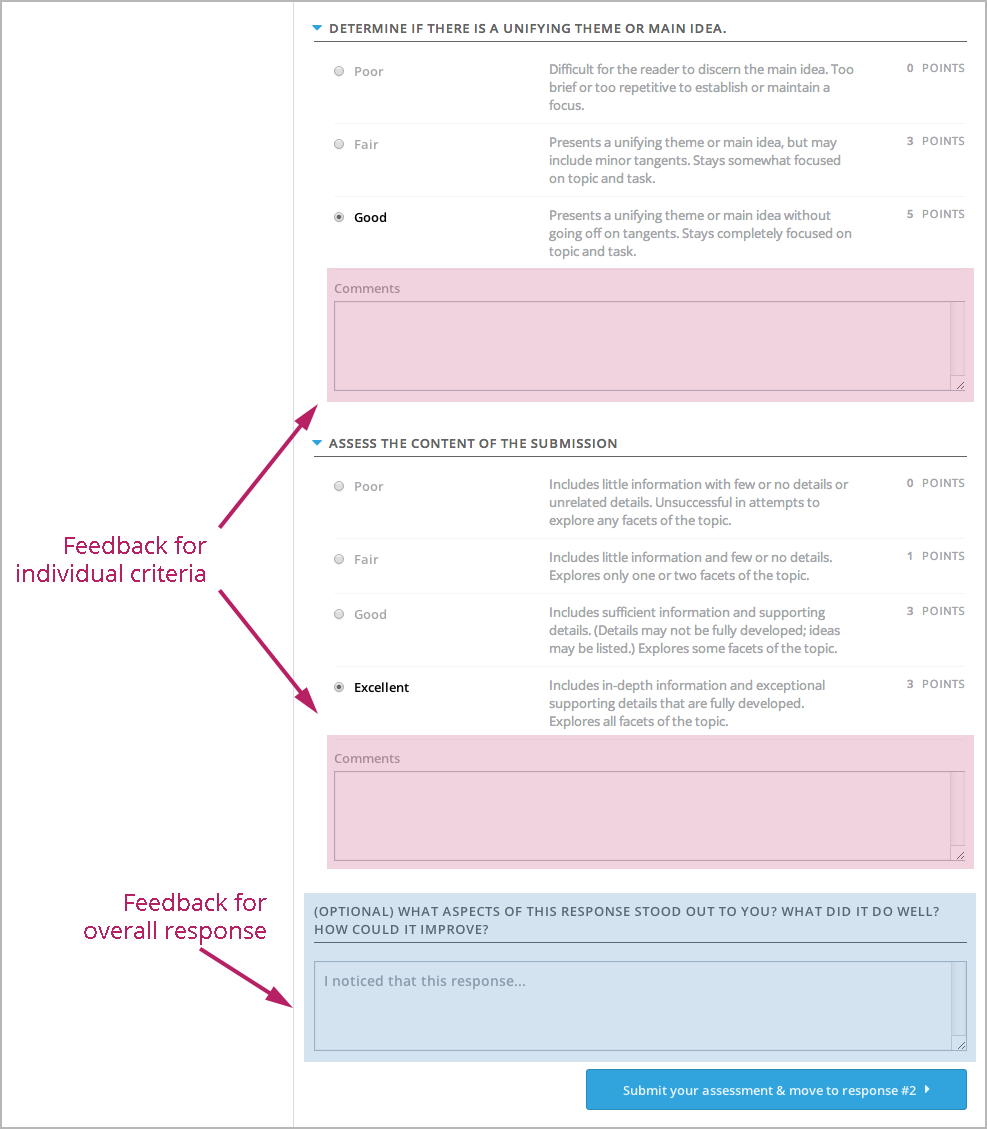
For more information, see Step 3. Add the Rubric and Provide Only Comment Fields for Individual Criteria.
8.31.1.3.3.2.3. Assessing Additional Responses¶
Learners can assess more than the required number of responses. After a learner completes the peer assessment step, the step “collapses” so that only the Assess Peers heading is visible.

If the learner selects the Assess Peers heading, the step expands again. The learner can then select Continue Assessing Peers to perform additional peer assessments.
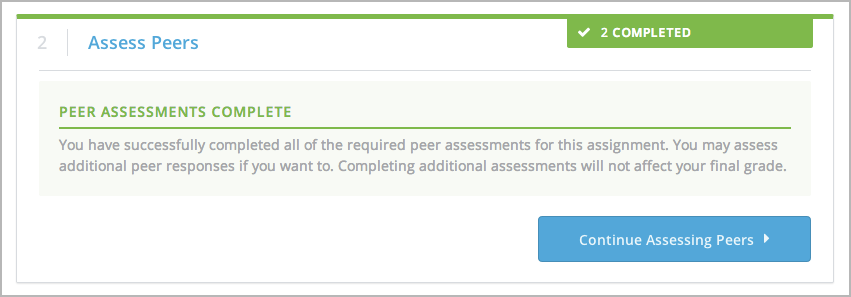
8.31.1.3.3.3. Self Assessment Step¶
In self assessment steps, the learner sees her own response followed by the rubric. As with peer assessments, the learner evaluates the response using the rubric, selecting an option for each criterion.
If you include both peer and self assessments, edX recommends that you include the peer assessment before the self assessment.
8.31.1.3.3.4. Staff Assessment Step¶
In staff assessment steps, a member of the course team performs an evaluation of the learner’s response. Course team members grade the response using the problem’s rubric, in the same way that self and peer assessments are done, and can include comments in their assessment.
Note
If a staff assessment step is included in an assignment, learners do not receive final grades until the staff assessment step has been completed. The scores that you give learners in staff assessment steps override scores from any other assessment type in the assignment, including peer assessments that are completed after the staff assessment.
Including a staff assessment step in an ORA assignment is best for courses with smaller groups of learners. For example, in a course with cohorts, you might create an ORA assignment that has both peer assessment and staff assessment steps, and make it available only to the members of one or more specific cohorts. For the members of the remaining cohorts, you create an ORA assignment that has only the peer assessment step. For details about creating different course experiences for learners in different cohorts, see Creating Cohort-Specific Course Content.
For details about performing grading in staff assessment steps, see Perform Staff Assessments in an ORA Assignment.
8.31.1.4. How Scores for Open Response Assessments Are Calculated¶
In open response assessments that contain staff assessments, staff assessments can be performed more than once, and the most recent staff assessment score is equivalent to the assignment’s final score. Peer and self assessment scores are not taken into account, although learners can see scores and comments from all assessments that were performed on their response.
In open response assessments that do not contain staff assessments but do contain both peer assessment and self assessments, only the peer assessment score counts toward the assignment’s final score. The self assessment score is not taken into account. There is no option for weighting the peer and self assessment portions independently.
In open response assessments that include only self assessments, the assignment’s final score is equivalent to the self assessment score.
Note
Given the high level of subjectivity in peer assessments, edX recommends that you make ORA assignments count towards only a small percentage of a course’s final grade.
The following topics detail how the scores for peer assessments and self assessments are calculated.
8.31.1.4.1. Peer Assessment Scoring¶
Note
If an open response assessment includes peer and self assessments but not staff assessments, only the peer assessment score counts towards the assignment’s final score. The self assessment score is not taken into account.
Peer assessments are scored by criteria. A number of peer assessors rate a learner’s response by each of the required criteria. The learner’s score for a particular criterion is the median of all scores that each peer assessor gave that criterion. For example, if the Ideas criterion in a peer assessment receives a 10 from one learner, a 7 from a second learner, and an 8 from a third learner, the Ideas criterion’s score is 8.
The learner’s final score on a response is the sum of the median scores from all peer assessors for all of the required criteria.
For example, a response might have received the following scores from peer assessors.
| Criterion Name | Peer 1 | Peer 2 | Peer 3 | Median |
|---|---|---|---|---|
| Ideas (out of 10) | 10 | 7 | 8 | 8 |
| Content (out of 10) | 7 | 9 | 8 | 8 |
| Grammar (out of 5) | 4 | 4 | 5 | 4 |
To calculate the final score for the response, add the median scores that were given for each criterion, as follows.
Ideas median (8/10) + Content median (8/10) + Grammar median (4/5) = final score (20/25)
Note
Remember that final scores are calculated by criteria, not by individual assessor. Therefore, the score for the response is not the median of the scores that each individual peer assessor gave the response.
For information on scores for learner submissions that you have canceled and removed from peer assessment, refer to Remove a Learner’s Response from Peer Grading.
8.31.1.4.2. Self Assessment Scoring¶
Note
If an open response assessment includes both peer and self assessments, the self assessment score does not count toward the final grade.
If an open response assessment includes only self assessments, the assignment’s final score is equivalent to the self assessment score.
Self assessments are scored by criteria. Each learner rates herself on each criterion, using the rubric. The learner’s final score on a response is the total number of earned points, out of the total possible points.
8.31.1.4.3. Staff Assessment Scoring¶
If an open response assessment includes a staff assessment step, the score that is given in the staff assessment step overrides all other scores in the assignment.
8.31.1.5. Top Responses¶
You can include a Top Responses section that shows the top scoring responses that learners have submitted for the assignment, along with the scores for those responses. The Top Responses section appears below the learner’s score information after the learner finishes every step in the assignment.
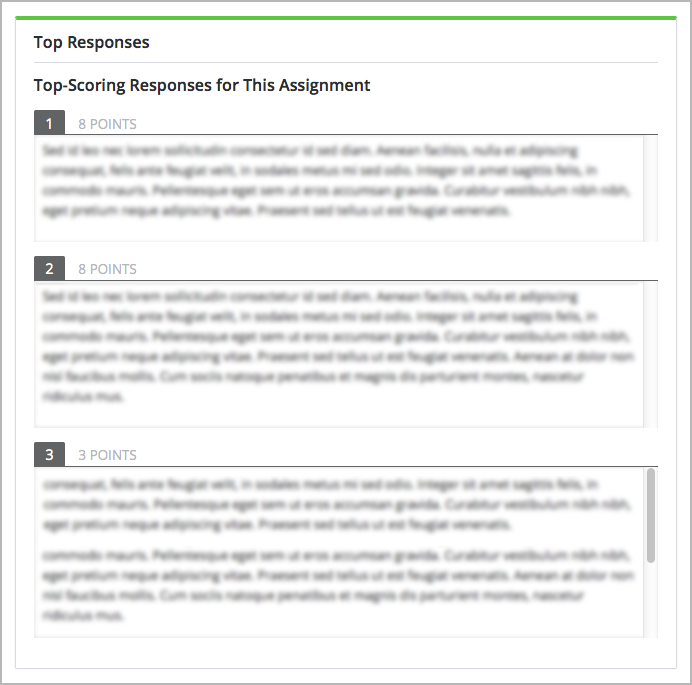
You can allow the Top Responses section to show between 1 and 100 responses. Keep in mind, however, that each response might be up to 300 pixels in height in the list. (For longer responses, learners can scroll to see the entire response.) EdX recommends that you specify 20 or fewer responses to prevent the page from becoming too long.
Note
It can take up to an hour for a high-scoring response to appear in the Top Responses list.
If a high-scoring response is removed from peer assessment it is also removed from the Top Responses list.
For more information, see Step 7. Show Top Responses.